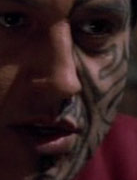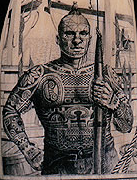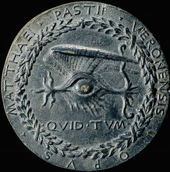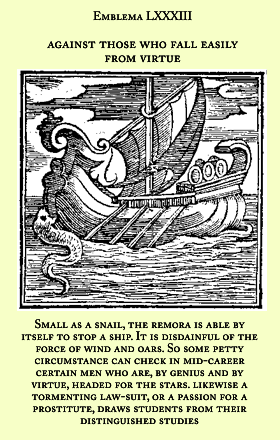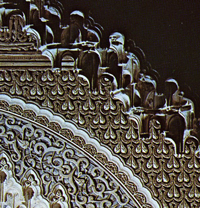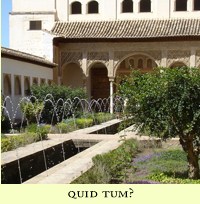
Norbiton: Ideal City is notable for its proliferation of emblems, as for instance the following:
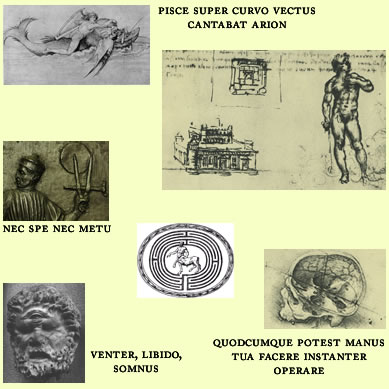
I am fond of emblems, and use them freely. A single emblem cuts across a given plane or facet of an object of knowledge - in our case the Ideal City of the Failed Life - and as a form of enquiry will mimic the confident glide of an exploratory scalpel - wholly apposite to an anatomy which is predicated on nimble if not in actual fact very accurate butchery. To emblematise a multiplanar city or any other complex object we require a number of swift passes, just as in the cinquecento emblems were published not individually but in books.
Hunter Sidney points out drily that if our aim is now to produce a book of emblems, then haven’t we already undertaken as much in designing and rearing up the Ideal City and in particular the Anatomy of Norbiton? And he adds that he would prefer not to live out what remained of his life circling ossified symbolical memories. He had thought, in short, that the Ideal City had freed us from all that.
If I am to infer from his outburst that he considers the Ideal City – perhaps cities per se – to be Anti-Emblems (spaces characterised, in other words, by an exhilarating plasma flow of fragmentary images and epigrams and mottos and commentaries) - then I would provisionally concur; but I would add that there is in every body of space a coagulating impulse, and consequently there is always a need for a little more finesse, some finer slicing, some more telling cut; there is – what it really comes down to – the unspoken quest for the emblem of all emblems – not a universal emblem, to be clear, but an emblem that might serve, if you like, as a rough pitch for the whole project: an emblem that answers the question, what is this [Ideal City, Anatomy] all about?
![]()
I think in any case I can cut Hunter Sidney off by noting that if we are to do more than talk in vague terms about the symbolical nature of everything, we should be clear about what it is that we understand by emblem. And we can in fact be quite precise.
The emblem is a composite literary/artistic form that was popular – immensely, puzzlingly so - from the sixteenth century on.
In its standardised form (see example, below) it is a tripartite design comprising motto, woodcut image, and discursive text or poem (inscriptio/motto/lemma : pictura : subscriptio) which interrelate to instance and explicate, typically, some moral commonplace or other.
The originary emblem book, the Emblemata of Alciati (Andrea Alciato, a Milanese jurist), was first printed in Augsburg in 1531 (unauthorised) and in Paris in 1534 (authorised, Christian Wechel), and then, after innumerable reprintings around Europe, in Venice in 1546 in an expanded edition by Aldus Manutius. It established the template for what was to be a protean form, and stayed in print for 350 years.
Gombrich notes that while we have no difficulty associating written word with musical setting, we have to make a considerable leap of the historical imagination to understand the linking of word and image. The emblem is not only a defunct form, it is an alien one. We do not like them. We do not like anything about them. While they are playful, they are not in the least funny, and not, properly speaking, ludic – there is no sense of Saturnalia, of the carnivalesque, about them. They are, frankly, a bit dull.
Renaissance emblematics, in short, is a dry brittle science, like a desiccated songbird; pick it up by its hooked toes; it weighs nothing.
![]()
As an example, we can take Alciati’s emblem no. 83:
The remora is a parasitical (or better, commensal) fish which locks on to a host (a shark, a turtle, a manta ray) and feeds on scraps from its host's table, as it were, or on their faeces. It was popularly believed to attach itself to ships in the same way, acting as a drag anchor. Pliny the Younger notes that the actions of the fish led to the defeat of Mark Anthony at Actium, retarding a key ship at a decisive moment.
By contrast, the relationship between woodcut and epigram is not commensal (or parasitic) but ostensive. Each points to the other, clarifies the other, focuses the other. The same is true in varying degrees of the motto and the epigram and the motto and the woodcut.
Whether, however, that ‘pointing to’ is a neutral act is debatable; it seems to me that the three parts in emblem 83 do not mutually inform so much as interfere with one another. There is, if you care to think about, a lively internal friction – the motto does not relate all that naturally to the epigram (Are we discussing the small chances of life that bring failure? Or the habitual (thus moral) failings of the failed agent?); the woodcut seems plain enough until you register the whale-like size of the fish that is hampering the ship; the epigram itself veers between the portentous and the inconsequential.
Emblems, we might conclude from this admittedly limited sample, are like a fish market of meaning, shout and counter shout. But perhaps we should take Emblem 83 at face value for a moment and allow the implicit connection between the apparently fleeting impedimenta of life and the moral failings of the impeded agent.
To that end I have attached an extended emblematic of my own.
I once nearly visited the Alhambra in Granada, but then didn’t.
I was holidaying with my Venetian Architect (architect of my downfall – perhaps I should just give her a name) in Southern Spain, and we arrived in Granada.
We were on a self-imposed and in retrospect meaninglessly tight schedule. We had allowed ourselves one morning to visit the Alhambra but at the ticket office they would only sell us tickets for the late-afternoon. We could, however, visit the gardens of the Generalife whenever we liked. So we went into the gardens for a look, and to decide what to do.
The Alhambra is the pinnacle of the ornamental arts, and as a historian, so to speak, of ornament (as I then considered myself to be) I had no excuse: I had to see the Alhambra.
We sulked around the gardens and, as I recall it, gave independent thought to the situation. I was feeling ill for some reason, giddy and feverish; (this was not my imagination: later, when we were driving away from Granada I had to have the Architect stop the car and I got out and vomited by the side of the road). Additionally, I was wearing a pair of espadrilles which the Architect had bought me a couple of days earlier in Cordoba, because for some reason I had arrived for the holiday wearing a pair of Doctor Martens, and they turned out to be too hot for Andalucía in September; but the white espadrilles had managed to rub the sides of my pasty feet to a gory mess, and were by now a bloodstained hobble.
So there I sit in the gardens of the Generalife, plagued with discontents.
My recollection of the Architect that day in the gardens is of a phantom presence; I seem to see her, in the obscurity of memory, only askance. I think I can picture her stepping through a door in a wall; walking up and down the opposite side of some water feature or other, approaching me obliquely to see if my louring mood had abated.
Anyway, we talked, and somehow we agreed not to wait, not to visit the Alhambra, and we left the gardens, possibly forever.
I do not understand why we did not change our plans. We had no plans worthy the name. I have a memory that we ended up that night in a pretty enough town, and that we argued about something on the balcony under the stars and slept in a sulk. There was something amiss and given the way we finished up I have to believe that it was something fundamental: a huge commensal fish hanging from the stern of our psychic ship, unremarked by either of us.
My point, and Alciati’s, I think, is that we tend to confuse all the facts of our life with impedimenta.
The facts of our life are given their particular valency - are organised, if you like - by our desires, our impulses, our woeful trajectory. The only way we can avoid polarising the facts of our life, attracting the remora so to speak, is either not to move, or to accommodate them within a circular narrative of struggle and defeat/victory. Either way, we will make negligible headway, and feel considerable retardation.
There is, to state the obvious, no remora. It is the facts of our life themselves that create the resistance.
![]()
According to Frances Yates the emblem functioned as part of a memory system. The image is a trigger: it springs the argument (the epigram) in your brain. To this end she quotes Aubrey’s life of Francis Bacon. Bacon, it seems, had emblematic images (“severall figures of beast, bird and flower”) placed in the painted glass windows lining the gallery of his house at Gorhambury; “perhaps his Lordship might use them as topiques for locall use”, speculates Aubrey.

I’m not so sure. Not only is it the case that Francis Yates saw memory systems everywhere, but, Bacon’s windows notwithstanding, there is something about the usual practice of enclosing emblems in a book that runs counter to the proposition. Turning the page of a book is in itself emblematic, so to speak, of forgetfulness (unless, I should note, you file away index cards like breadcrumbs); if you wish to meditate on something, you need your object in plain view. Although even then, placing the object of contemplation in plain view tends to dull the perception; after a while, we cease to notice it, it disappears (as the puddle-eyed old Chancellor of England might fretfully have noticed, pacing his galleries).
Emblems in the Ideal City, then, are as the tattoos on the flesh of South Sea Islanders, or the tattered much-consulted lists of obsessives, or the freshly chiselled inscriptions on tombstones: they are a way, not of remembering, or memorialising, but of placating the memory. Write something down and you need no longer carry it in your head. It is out there, in the known world. You can forget it.
![]()
In The Albert, Clarke shows us his tattoos.
 I have just returned from some work in the Kelley garden, an aggravating day uprooting a bramble bush. Clarke had been present, and had at one point unnecessarily taken his shirt off. I mention this now to Hunter Sidney, and Clarke hoiks up his T-shirt, as if called on to corroborate in a court of law.
I have just returned from some work in the Kelley garden, an aggravating day uprooting a bramble bush. Clarke had been present, and had at one point unnecessarily taken his shirt off. I mention this now to Hunter Sidney, and Clarke hoiks up his T-shirt, as if called on to corroborate in a court of law.
He is by no means a Chakotay among men, or a Queequeg; his doughy albino flesh against the sickly cuprous green of the tattoos, welded to the inexpert workmanship of the designs (which were started by an artist friend in Rome, and finished by his girlfriend Mandy, who not only completed the design and provided the inscription, but also stretched her more ornate and uninhibited hand over the hesitant scratchings of her forebear or, as Clarke puts it, freshened them up) – in short, the tattoos are not a particularly pretty sight.
However, they have an emblematic status. They are located in a cluster over his left shoulder blade, and are underwritten by a brief motto-like inscription, homo, fuge! They are, in order, an Egyptian ankh (although Clarke calls it an’omunculus), a lithium atom – both the work of his artist friend in Rome – and an anchor.

He talks us briefly through them. The ankh, he says, stands for the vita comtemplativa (as explained to him by his Roman friend); the lithium atom is the ‘material basis of life’ (lithium, because three electrons worked better than, say, one, or seven, although at first glance the design resembles a childish flower); the anchor he passes over. Perhaps it is just an anchor. The motto, homo fuge! is from Marlowe’s Faust: it appears in his congealing blood when he signs away his soul. Clarke seems to interpret it as a general lament on the restless of his life ('omunculus fuge!)
He pulls down his T-shirt and we sip our pints. I ask him why, if he was moved over the years to scratch an indelible emblem into his flesh, did he put it in a place where he could never see it; he responds by mildly pointing out that he never sees his arse either, but is reasonably secure in the knowledge that it is at large and doing good work in the world of signs.
![]()
Neither Clarke’s tattoos nor what I have called the emblems of the Ideal City are emblems, strictly understood: they are closer, in total-emblem-space (see glossary), to the region of what are called devises, or imprese. An impresa was, among other things, personal to an individual rather than general to a moral problem, and was typically bi-partite (motto and image) rather than tri-partite.
Needless to say, the taxonomy of a dead art is scarcely relevant to our current purpose: what is relevant is that both Clarke’s tattoos and the devises of Norbiton and much else in the Ideal City besides, derive from an emblematising sensibility.
The moment you choose to write something down, or chisel it into of a block of wood, rather than let it float by and mutate and collide with other possible ideas in total-idea-space, is an emblematic moment akin to the minting of a coin or the shaping of a block of stone. The idea is liberated from the ether of possibility into the cut marble of actuality.
Marble can be reused and coin melted down, and the picture and motto of an emblem are similarly not permanent; emblems have, nevertheless, for a given time and place, a certain currency. Just as we do not pull value out of the air when we buy a pint of milk, but rather fish in our pockets and draw out coins of accepted worth; so when we speak and think we do not create meaning at will from the electrified puddle of our brains, but from known units.
There was much debate in the cinquecento regarding the ontological status of emblems: were they simply metaphors, as Aristotle would have understood the term? Or did they approach the status of platonic forms?
We now know the latter to be the case.
![]()
As the sixteenth century drew towards the seventeenth, emblems were not created so much as excavated, and Alciati came to be regarded as what he was not: an antiquarian.
An antiquarian approach to emblematising was not just a merit but a necessity because the emblematiser was increasingly seen as travelling back towards the font of (arcane, religious) knowledge; the explorer in these realms had to be equipped with a discriminatory understanding of ancient statuary, coins, medals and their reverses, intaglios, seals, inscriptions, classical texts, and so on. Individual emblems were refined, edited, brought closer, it was believed, to their Adamic and hieroglyphic sources.
And books of emblems came to be organised, not just as cabinets of curiosities (a word often associated with emblem books) but with taxonomical rigour, reflecting, in certain cases, the whole of the created universe. If emblems 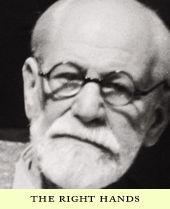 were a way of mapping the platonic forms, a sort of mystical brass-rubbing, then any action coming to pass in the world of accidental reality would of necessity fall within some known region or other, would be closer to this or that emblem – strange attractors in total-emblem-space. It was, in the right hands a powerful, or at any rate, a persuasive science.
were a way of mapping the platonic forms, a sort of mystical brass-rubbing, then any action coming to pass in the world of accidental reality would of necessity fall within some known region or other, would be closer to this or that emblem – strange attractors in total-emblem-space. It was, in the right hands a powerful, or at any rate, a persuasive science.
It is in this more developed sense of what an emblem and an emblem book is that I now understand Hunter Sidney’s somewhat embittered and I might say emblematic observation - that Norbiton: Ideal City is (or could come to be) in itself an emblem of emblems.
I think it is now clear that the Ideal City is not an emblem; rather it is the space in which and by which our emblems (projects, ideas, failures, memories, lives) are organised, given their characteristic valency.
The accidental city, after all, is made up of functions and regions and buildings that are present and mappable not only in physical but in emblematic space — lawcourts, churches, universities, barracks (each with their own emblematic accoutrements); suburban houses with nameplates and gates and gardens, electricity sub-stations emblazoned with signs, shops giddy with logos and slogans, billboards epigrammed with copy. To be sure, not all of these are emblematically understood by everyone, all of the time; but that is the nature both of the emblem (which is a temporal as much as a spatial arrangement) and of the accidental city.
If the Ideal City is similarly a configuration of emblematic space, then its individual emblems are likely to inhabit the inter-emblematic space of the empirically real and accidental cities, insofar as the three intersect - they will tend to avoid, in other words, the gravitational pull of the emblems of the virtues and vices of the empirical city (success, passion, journey, creativity, negativity, what you will); and in order for this to be more than a temporary state of affairs, a futile ad hoc resistance, it is necessary to build a rival system of resistance - a structure of anti-emblems, if you will.
![]()
If I seem obscure (and I am not), then this is in part a function of existing too long in the superficially quirky emblem-space of the Ideal City, breathing a little too much of that radiant air.
The Emblems of the Ideal City are, simply enough, both a form of enquiry and an object of knowledge. They are, unlike those of the sixteenth and seventeenth centuries, neither cabalistic, arcane, invocatory, talismanic, nor magical.
Take as an example this painting and its emblematic particularity in the Ideal City.
The painting, entitled Landscape with the fall of Icarus, hangs in the Musée des Beaux Arts in Brussels. It was long believed to be by Bruegel, but is now thought to be a copy after Bruegel.
It is traditionally interpreted as either (or both) a visual gloss on Ovid’s relation of the tale of Icarus in the Metamorphoses (which mentions among other things the ploughman, the shepherd and the fisherman), and/or a development of a Dutch proverb about the plough still running on in the presence of death. Both W.H Auden and William Carlos Williams composed emblematic epigrams in its honour.
I have never visited the gallery and have never seen the painting.
Clarke, who has seen the painting, offers a rival interpretation. He tells me that what struck him as he stood in front of it was the claustrophobic nature of labour, or more precisely, the illogicality of the space: in particular, that horse and plough would never be able to turn in that field; the shepherd’s sheep are toppling off their narrow terrace; the fisherman is sitting on a giddy ledge. It is, says Clarke (and contrary, I should say, to what we think we know of Bruegel) not a moral observation on the virtues of honest striving but an aspirational, or, perhaps better, a defiant, or even a revolutionary painting; where Icarus is falling into the water, an ‘expensive delicate ship’ is setting sail for the immense dreamlike burnished paradisical beyond; Icarus, surmises Clarke (as earthbound a striver as you could wish to know) was right to strive, to try, to risk all. And right to fail.
Maybe so, but to my eye, that ship is in the grip of a remora. All that straining sail, and only the most trivial of bow wakes to show for it. It is going nowhere, it is a ship of poignant failure.
There is on a shelf in my room a postcard of this painting, that was sent to me twenty years ago by an absent and now seldom remembered girlfriend who was in Brussels for some reason. She has scribbled an affectionate message on its reverse. A message of affectionate remembrance from one forgotten youth to another. Occasionally (dusting my shelves?) I turn the card over and read the message, and flail for an actual memory - of the day I received it, say, or of our reunion after her return. Without success. I only know that she was absent and sent this postcard, which clings to me now like seaweed.
 There was a time when everything I wanted was elsewhere. I did not travel abroad for the first time until I was 18. There was no Internet. There were three and then four channels of television, my knowledge of the world was generally filtered through Alan Whicker (eugh!); and there were books. Foreign travel to anywhere worth the bother was expensive; the actuality of foreign places hard to conceive. I remember discovering with a shock that it was possible to visit the Sistine Chapel.
There was a time when everything I wanted was elsewhere. I did not travel abroad for the first time until I was 18. There was no Internet. There were three and then four channels of television, my knowledge of the world was generally filtered through Alan Whicker (eugh!); and there were books. Foreign travel to anywhere worth the bother was expensive; the actuality of foreign places hard to conceive. I remember discovering with a shock that it was possible to visit the Sistine Chapel.
Then later, having travelled a little and lived abroad, I found myself in Norbiton, and again there was nothing. I occupied a volume of space (my room) and went out to work, (in accidental Norbiton) or watched Star Trek (in empirically real Norbiton). The place I was in asserted itself as anchor or remora.
The Ideal City, by contrast, is an exercise in immanence. It would be irrelevant to go chasing after what is not here. Everything, after all, in one form or another, is here. Nevertheless, somewhere, I know, that painted object hangs in a room with other paintings by Bruegel (which ones? Clarke could not remember). I know that it hangs in a corner room (if they haven’t moved it), but what would I see if I turned my head? Or walked out of the room, out of the museum? I do not know, and it is anyway not a question of knowing, but of experiencing. I do not just recall, I fully remember what it is like to be away from here, wherever here is. I fully remember what it is like to be in a strange place.
![]()
It is apt that we should conclude with a painting – the Bruegel - because a painting hanging in a gallery naturally offers itself as part of an emblematical system. There is a title, the painting itself, a note of technique, date, provenance, perhaps a brief interpretative description; there is the conversation between viewers, or in the viewer’s head, a description of what is seen, such that our understanding of the painting starts with our description of it, whatever it is we pick out for comment.
In the same way, our actions are available for emblematic positioning. Not every action, not all the time. But as we talk through our memory of sequence, our understanding of causation, we provide a rolling epigram to the indelible woodcut of act; and the whole (rhetorical) package will then be available to a series of triggers (call them mottos); and in this way, as we try to navigate the various predicaments of life in, for example, Early Modern Norbiton, we invoke and deploy our emblems in conversations both interpersonal and internal, and whether we do so haphazardly, repetitively, or with skill, we are nevertheless clinging to them like so many floating spars and splinters of wood.
Perhaps it is sufficient. After all, as I keep reminding myself, an emblem, etymologically, is an ornamental fragment.


